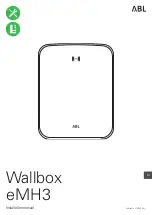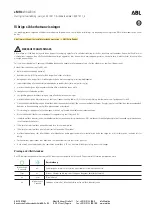
4
646-1299
This battery charger is equipped with a self-resetting circuit
breaker. This device protects the charger from temporary over-
loads. In the event of an overload, the circuit breaker will trip
open and after a short cooling off period will reset automatically.
This process is known as cycling and can be recognized by an
audible clicking sound.
NOTE:
Clicking sound is normal. Wait until charger automati-
cally resets itself.
CAUTION:
Persistent clicking (more than 30 minutes) may indi-
cate reverse connection or shorted battery cells. (See
TROUBLE-
SHOOTING
)
OPERATING INSTRUCTIONS: CHARGING BATTERY OUT OF THE VEHICLE
When charging battery out of the vehicle, take care to determine the battery type. To reduce risk of a spark near battery, follow these steps
when battery is outside vehicle.
WARNING:
A spark near battery may cause battery explosion.
WARNING:
When removing battery from
vehicle or boat, disconnect grounded post first. When disconnecting, make sure all accessories are off, so as not to cause an arc.
(
NOTE:
A marine (boat) battery must be removed and charged on shore. (To charge on board requires special equipment designed for
marine use.)
WARNING:
When reinstalling battery, attach the ground post first.
Conventional and Low Maintenance Batteries.
These are the
antimony/lead batteries. Conventional/Low Maintenance bat-
teries require periodic addition of water to the acid solution
(electrolyte). Additional water may be added by removing the
filler caps located on the top of the battery.
IMPORTANT:
When antimony is known to be one of the materi-
als used in the battery's construction, that battery is a Low Main-
tenance/Conventional type.
CAUTION:
Some Low Maintenance batteries have a relatively
smooth top without any apparent battery filler caps. If, however,
the battery manufacturer/distributor recommends periodic
checking of electrolyte level and provides access to the battery
for water additions, the battery is probably a Low Maintenance/
Conventional type.
Maintenance Free Batteries.
These are calcium/lead batteries
and normally do not require water additions. Therefore, filler
caps have been removed from the battery surface. These bat-
teries will have a smooth or sealed appearance.
Deep Cycle Batteries.
These heavy duty batteries are used in
boats, construction equipment, sump pumps, etc. They are nor-
mally marked
DEEP CYCLE
on the outside of the case.
MANUAL VS. AUTOMATIC CHARGING
In the AUTOMATIC positions, the charger will only turn ON when
it is connected to a battery with a voltage over .7 volts. In the
MANUAL position, the charger will turn ON under any condition.
If a battery is so depleted of charge that its voltage is less than
.7 volts, switch to the MANUAL position for a few minutes before
switching to an AUTOMATIC position.
DELCO VOYAGER AND SIMILAR BATTERIES:
Some batteries, especially those with a built-in 'State of Charge'
indicator that have been deeply discharged, may require the
use of the MANUAL position in order to obtain a full charge. To
bring a Delco Voyager battery to full charge, first charge in the
Automatic (Maintenance Free) mode until the Full Charge LED
glows, then switch to the Manual Mode until the built-in 'State of
Charge' Indicator turns green. The AUTOMATIC position may
be used to maintain the battery at Full Charge.
DESULFATION MODE
If your battery has been left discharged for an extended period
of time, it may have become 'SULFATED'. If your battery voltage
is less than 12.2 volts prior to being charged, and the voltage
climbs rapidly when you first start charging, your battery may be
SULFATED. Under this condition, the charger enters
DESULFATION MODE (if it is in an AUTOMATIC position). In
DESULFATION MODE, the initial charging current is very small.
The charger will stay in DESULFATION MODE for 24 hours,
attempting to break down the sulfation. If the battery current
increases to normal in this time, the charger will enter the nor-
mal AUTOMATIC MODE. If the current does NOT increase to
normal, the charger will enter the ABORT state and will shut off.
The ABORT state is indicated by the rapid flashing of the RED
LED.
NOTE:
A buzz or hum is normal when the output cables have
been disconnected and the AC power cord is still connected to
an electrical source (i.e. wall outlet).
These types of noises will also occur when the green light
comes on indicating the battery is "Completely Charged". At
this point, the charger has stopped charging the battery, but still
hums or buzzes until the electrical power is shut off.
CIRCUIT BREAKER
BATTERY TYPES
Three basic types of lead-acid batteries can be given a charge with this charger: (1) Conventional and Low Maintenance,
(2) Maintenance Free, (3) Deep Cycle / Marine.


































